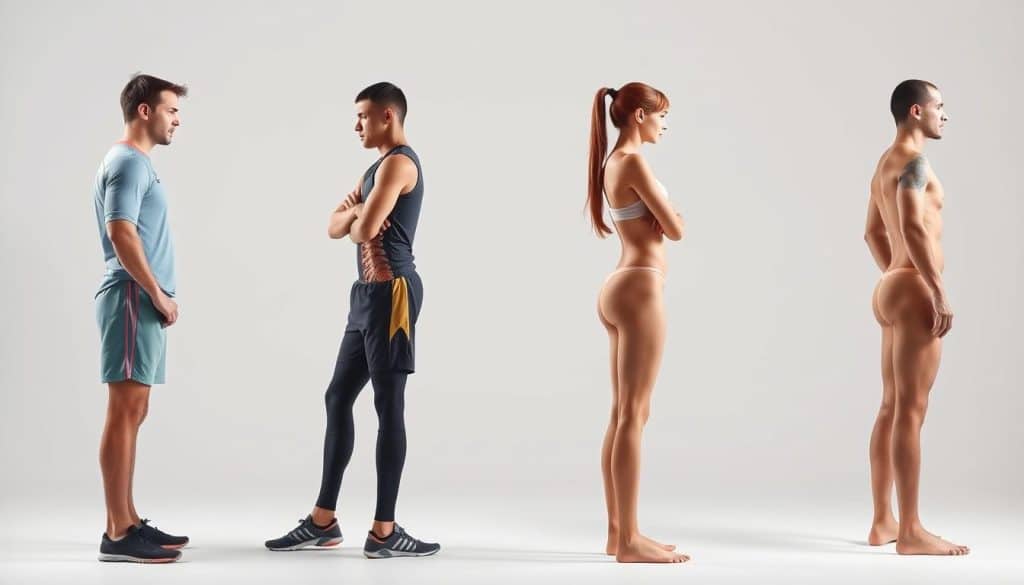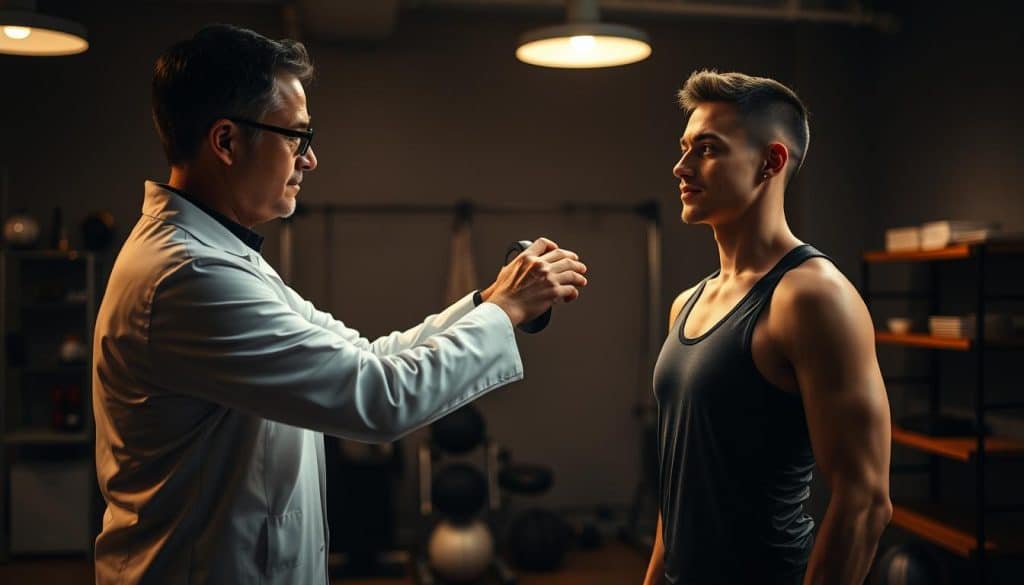Did you know football players face 4.47 injuries for every 1,000 hours of play? Research shows many stem from hidden alignment issues that affect how bodies move. At Riverside Sports Therapy, we uncover these challenges before they sideline your progress.
Our Calgary clinic specializes in detailed movement analysis tailored to active individuals. By evaluating both stationary positions and dynamic actions, we pinpoint imbalances that strain joints or muscles. This dual approach helps athletes avoid repetitive stress and recover faster.
Consider how minor alignment shifts can alter throwing mechanics or running efficiency. Our methods blend scientific analysis with practical solutions, addressing root causes rather than symptoms. Whether you’re training for hockey or track, early detection prevents small issues from becoming major setbacks.
Key Takeaways
- Football players experience 4.47 injuries per 1,000 hours of activity due to alignment issues
- Combining static and dynamic evaluations reveals hidden performance barriers
- Localized strategies reduce strain on joints and muscle groups
- Early intervention prevents chronic pain and training interruptions
- Custom solutions match the demands of hockey, soccer, and other sports
Introduction to Postural Assessments for Athletes
Hidden alignment issues can silently sabotage your training progress. At Riverside Sports Therapy, we decode these invisible challenges through specialized evaluations that map your structural balance. Our approach combines cutting-edge technology with sports-specific expertise to keep you competition-ready.
These evaluations examine how your joints and muscles work together during rest and motion. We measure angles, weight distribution, and movement patterns using photogrammetry – a precise imaging method proven in clinical studies. This reveals imbalances that traditional exams might miss.
Three key factors make our process unique:
- Sport-specific calibration for hockey, soccer, and track demands
- Quantitative data tracking changes over time
- Preventive strategies that address root causes
Your training regimen creates unique physical adaptations. A swimmer’s shoulder rotation differs from a cyclist’s spinal position. Our team interprets these nuances to create actionable plans. Early detection of alignment shifts helps maintain power transfer and reduces injury risks.
We transform findings into customized exercise regimens that complement your existing workouts. This proactive method ensures your training hours translate into measurable gains, not preventable setbacks.
Understanding Posture and Its Role in Athletic Performance
Your stance during rest directly influences how you move under pressure. At Riverside Sports Therapy, we decode the hidden relationship between structural balance and peak output. Let’s explore what separates efficient positioning from problematic patterns.

The Blueprint of Balanced Positioning
Optimal posture occurs when muscles work equally on both sides of your frame. Your pelvis stays neutral, while the spine maintains its natural S-curve. Picture an imaginary line running from your earlobe through shoulder center, hips, knee joints, and ankle midpoint.
Deviations happen when your center shifts away from this alignment. Compensations develop – like tight hip flexors in cyclists or rounded shoulders in swimmers. These adaptations drain energy and distort movement mechanics.
From Alignment to Outcomes
Even minor shifts impact power transfer. A forward-leaning stance adds strain to knee joints during sprints. Rotated hips alter throwing accuracy in baseball players. We measure how these variations affect:
- Energy expenditure during endurance activities
- Force generation in explosive movements
- Recovery needs between training sessions
Proper alignment lets hockey players maintain edge control during sharp turns. It helps runners conserve energy over long distances. By restoring balance, you convert wasted effort into measurable results.
The Science Behind Postural Assessment
Precision matters when evaluating structural balance. Our Calgary clinic combines peer-reviewed research with advanced measurement tools to map your body’s unique mechanics. This evidence-based approach reveals hidden patterns affecting performance.
Research and Local Government Data
A landmark study of 263 youth football players used photogrammetry and SAPO® software to identify critical alignment trends. Key findings showed 21.4%-50% right-side shoulder misalignments and 42.9% pelvic positioning issues. These patterns highlight why standardized evaluations often miss sport-specific risks.
Methodologies and Observational Techniques
We employ multi-angle evaluations combining digital imaging and motion tracking. Our team cross-references spinal angles with pelvic tilt measurements (-15.4° average deviation in hyperlordosis cases). This dual approach captures both static imbalances and dynamic compensation habits.
Three principles guide our process:
- Quantitative data from validated measurement systems
- Sport-specific benchmarks for hockey, soccer, and track
- Time-lapsed comparisons to track progress
By merging clinical insights with athletic movement patterns, we create correction plans that address root causes. This science-backed strategy helps you maintain optimal alignment through seasons of intense training.
Steps to Conduct a Thorough Postural Assessment
Accurate evaluations begin long before you step into the room. Our systematic approach combines precise environmental controls with multi-angle observation protocols. This ensures every detail contributes to actionable insights about movement patterns.
Preparing the Assessment Environment
We start with controlled lighting to eliminate shadows that distort visual analysis. Ample space allows our team to move freely while observing clients from all angles. You’ll wear fitted clothing and remove footwear to reveal natural alignment markers like shoulder symmetry and hip positioning.
Observing From Multiple Angles
Our experts examine three primary views during the 30-minute session. The front view highlights shoulder level differences and foot rotation. Side perspectives reveal spinal curvature and weight distribution. Rear observations uncover pelvic tilts and muscle asymmetry.
We document findings systematically, starting at the head and working downward. This top-to-bottom method prevents missed comparisons between joint relationships. Standardized positioning—feet shoulder-width apart, arms relaxed—creates consistent reference points across sessions.
Identifying Common Postural Deviations in Athletes
Did you know 7 out of 10 competitors show measurable knee alignment shifts during routine screenings? These structural changes often develop from repetitive motions in sports like hockey or soccer. Our team deciphers these patterns to protect your performance.

Spotting Muscle Imbalances
Training demands create predictable tension patterns. Swimmers often develop rounded shoulders from pool sessions, while runners might experience flattened lower back curves. We map these variations through:
- Spinal curvature analysis (excessive arching or flattening)
- Shoulder rotation measurements
- Hip displacement tracking
Analyzing Deviations and Their Implications
A forward head position adds 10 pounds of pressure per inch of forward tilt. This common shift strains neck muscles and reduces breathing efficiency. Lateral spinal curves alter power transfer in rotational sports like golf or baseball.
Knee alignment proves particularly telling – studies show 50%-91% of active individuals present with inward knee angles. These variations increase ACL injury risks during pivots or jumps. Our corrective strategies address both visible shifts and hidden muscle coordination issues.
Effective Postural Assessment for Athletes
What separates good evaluations from game-changing insights? Precision measurement systems designed for active bodies. Our Calgary clinic uses sport-specific protocols to map structural patterns affecting your power output and recovery.

Precision Measurement Systems
We analyze seven key markers during every session. Shoulder height differences reveal uneven muscle development. Hip alignment shifts expose rotational imbalances from repetitive motions. These measurements combine with dynamic tests showing how your frame handles sport-specific stresses.
Our process includes:
- Digital tracking of spinal curves and joint angles
- Weight distribution analysis across both feet
- Movement pattern comparisons to sport benchmarks
Standardized documentation ensures consistent tracking. Photographic records create visual timelines showing progress between sessions. This approach helps hockey players maintain proper pelvic positioning during slap shots and lets runners optimize stride efficiency.
Environmental controls eliminate variables affecting results. Proper lighting and floor markings ensure repeatable testing conditions. You’ll receive clear data showing how minor adjustments can prevent major setbacks in your training cycle.
Strategies for Correcting Postural Imbalances
Effective movement starts with balanced foundations. Our Calgary team crafts personalized plans that strengthen weak areas while improving mobility. These solutions evolve with your progress, keeping your body aligned with sport demands.
Targeted Corrective Exercises
We address muscle imbalances through precise movements. Scapular retractions build upper back strength for rounded shoulders. Thoracic extensions counter slouched positions common in hockey players. Hip flexor stretches ease strain from repetitive kicking motions in soccer.
Lower back stability improves through glute bridges and lumbar extensions. These exercises restore natural spinal curves disrupted by cycling or weightlifting. Chin tucks realign forward head positioning from swimming strokes or tennis serves.
Customized Training Adjustments
Your program adapts to prevent recurring issues. We modify workout angles to reduce joint stress during lifts. Balance drills enhance stability for uneven surfaces in trail running. Recovery techniques address tight hamstrings from sprint training.
Progress tracking ensures lasting changes. Photographic comparisons show improved shoulder alignment over 6 weeks. Strength metrics reveal increased core endurance for martial artists. These adjustments help maintain proper form through growth phases or intense competition schedules.
